Enhancing Road Safety Decision-Making through Analysis of Youth Survey Data: A Descriptive Statistical Approach
Abstract
1. Introduction
2. Literature Review
2.1. Global Overview of Road Safety and Its Impact on Sustainable Development
2.2. Morocco’s Overview
2.3. National Road Safety Strategy of Morocco
3. Materials and Methods
3.1. Survey Design
3.2. Data Collection
4. Results of the Quantitative Research
4.1. Demographic Profile
4.2. Road Safety Perceptions
4.3. Involvement of Youths
4.4. Open-Ended Question Outcome
5. Discussion
5.1. General Discussion
5.2. Linking Youth Suggestions to Established Road Safety Studies and Strategy
5.3. Aligning the Study’s Perspectives with Prior Research
5.4. Key Policymaker Considerations
- Integrating the perspectives and insights of young individuals can lead to the development of more comprehensive and contextually relevant road safety measures.
- Organizing periodic meetings with young individuals enables continuous feedback and updates, fostering their engagement and ownership in road safety initiatives.
- Empowering youth ambassadors involves designating youth representatives as envoys in policymaking and implementation processes to ensure a more effective representation of youth interests and concerns in road safety strategies.
- Utilizing renewable energy sources, such as solar and wind power, in the transportation infrastructure can contribute to sustainability goals while minimizing the environmental impact.
5.5. Limitations and Further Research
6. Conclusions
Author Contributions
Funding
Institutional Review Board Statement
Data Availability Statement
Acknowledgments
Conflicts of Interest
Appendix A
- Part A. Background Information
- A1. Are you:
- E2. Age:
- Part B: Transportation and Road Safety
- B1. Do you currently possess a valid driver’s license?
- B2. What is your primary mode of transportation daily?
| ⬜ |
| ⬜ |
| ⬜ |
| ⬜ |
| ⬜ |
- B3. Have you or anyone in your immediate surroundings experienced a traffic collision before?
- B4. Have you personally been involved in a traffic collision resulting in a fatality or serious injury?
- B5. In your estimation, how many fatalities occur daily in Morocco due to road collisions?
- Mark one only
| ⬜ |
| ⬜ |
| ⬜ |
| ⬜ |
| ⬜ |
- B6. What, in your opinion, are the main causes of road collisions?
| ⬜ |
| ⬜ |
| ⬜ |
| ⬜ |
| ⬜ |
- B7. In your view, who bears the responsibility for reducing the number of fatalities and injuries resulting from road collisions?
| ⬜ |
| ⬜ |
| ⬜ |
| ⬜ |
| ⬜ |
- C2.
- Based on your personal experience, how would you evaluate your involvement in volunteer work, considering contributions to community-building and NGOs?
| Low | High | |||
| 1 | 2 | 3 | 4 | 5 |
| ⬜ | ⬜ | ⬜ | ⬜ | ⬜ |
- C3.
- Have you participated in a project that influenced public policy or the decision-making process?
- Part D: Youth Integration and Decision-Making
- D1. Integrating young people into decision-making processes is a vital necessity.
| Strongly agree | Agree | Disagree | Strongly disagree |
| ⬜ | ⬜ | ⬜ | ⬜ |
- D2. The role of youth and NGOs is crucial in raising awareness within the community.
| Strongly agree | Agree | Disagree | Strongly disagree |
| ⬜ | ⬜ | ⬜ | ⬜ |
- D3. Consultations with young people alone are insufficient for their integration into decision-making.
| Strongly agree | Agree | Disagree | Strongly disagree |
| ⬜ | ⬜ | ⬜ | ⬜ |
- D4. It is necessary to have a representative from the youth category in decision-making chambers.
| Strongly agree | Agree | Disagree | Strongly disagree |
| ⬜ | ⬜ | ⬜ | ⬜ |
- D5. Young people are capable of influencing the decision-making process.
| Strongly agree | Agree | Disagree | Strongly disagree |
| ⬜ | ⬜ | ⬜ | ⬜ |
- Part E: National Road Safety Awareness
- E1. Are you aware of the role of NARSA?
- E2. Are you familiar with the National Road Safety Plan?
- E3. Do you believe road safety should be a top national priority, considering its critical and pressing nature?
- E4. Would you be willing to participate in volunteer work to contribute to the implementation of the objectives of the National Road Safety Plan?
- Part F: Youth Inclusion in Road Safety Policymaking
- F1. Among the following options, what is the most effective mechanism for ensuring the inclusion of Moroccan youth in road safety and sustainable transport policymaking?
| ⬜ |
| ⬜ |
| ⬜ |
| ⬜ |
| ⬜ |
| ⬜ |
- F2. Share your opinion on how we can activate the role of youth in participating in the development and implementation of the National Road Safety Policy:
| ⬜ |
| ⬜ |
| ⬜ |
| ⬜ |
| ⬜ |
| ⬜ |
| ⬜ |
| ⬜ |
- F3. If you were integrated into road safety decision-making, what suggestions would you prioritize to reduce the number of deaths and injuries resulting from road crashes?
References
- WHO. «Road Traffic Injuries ». June 2022. Available online: https://www.who.int/news-room/fact-sheets/detail/road-traffic-inju-ries#:~:text=Road%20traffic%20injuries%20are%20the%20leading%20cause%20of,a%20disability%20as%20a%20result%20of%20their%20injury (accessed on 18 May 2023).
- Ahmed, S.K.; Mohammed, M.G.; Abdulqadir, S.O.; El-Kader, R.G.A.; El-Shall, N.A.; Chandran, D.; Rehman, M.E.U.; Dhama, K. Road Traffic Accidental Injuries and Deaths: A Neglected Global Health Issue. Health Sci. Rep. 2023, 6, e1240. [Google Scholar] [CrossRef] [PubMed]
- Huguenin-Richard, F. Mobilité urbaine: De l’automobilisme à l’éco-mobilité. Un long chemin…. In Mobilités; Armand Colin: Paris, France, 2010; pp. 109–137. [Google Scholar]
- Porter, G.; Turner, J. Meeting Young People’s Mobility and Transport Needs: Review and Prospect. Sustainability 2019, 11, 6193. [Google Scholar] [CrossRef]
- Rajput, A.A.; Mostafavi, A. Latent Sub-Structural Resilience Mechanisms in Temporal Human Mobility Networks during Urban Flooding. Sci. Rep. 2023, 13, 10953. [Google Scholar] [CrossRef] [PubMed]
- Geoffron, P.; Thirion, B. Décarboner les Transports et les Mobilités: Quelles Réponses Efficaces Face aux Urgences? Université Paris Dauphine-PSL: Paris, France, 2023; p. 64. [Google Scholar]
- Durieux, M.; Pouleur, J.-A.; Scoubeau, C. Une approche transdisciplinaire de la problématique de la mobilité scolaire à Mons (Belgique). Enjeux Société 2023, 10, 132. [Google Scholar] [CrossRef]
- Von Beesten, S.; Bresges, A. Effectiveness of Road Safety Prevention in Schools. Front. Psychol. 2022, 13, 1046403. [Google Scholar] [CrossRef]
- Saleem, S. Risk Assessment of Road Traffic Accidents Related to Sleepiness during Driving: A Systematic Review. East. Mediterr. Health J. 2022, 28, 695–700. [Google Scholar] [CrossRef] [PubMed]
- Chang, F.-R.; Huang, H.-L.; Schwebel, D.C.; Chan, A.H.S.; Hu, G.-Q. Global Road Traffic Injury Statistics: Challenges, Mechanisms and Solutions. Chin. J. Traumatol. 2020, 23, 216–218. [Google Scholar] [CrossRef] [PubMed]
- Mussone, L.; Alizadeh Meinagh, M. A Crash Data Analysis through a Comparative Application of Regression and Neural Network Models. Safety 2023, 9, 20. [Google Scholar] [CrossRef]
- Ellizar, E.; Larastiti, S.; Bawono, T.E.; Mulyana, W.; Kurniawan, C. Youth Participation in School Safety Zones Assessment: A Case Study in Indonesia. JRS 2023, 34, 1–9. [Google Scholar] [CrossRef]
- World Health Organization. Global Plan for the Decade of Action for Road Safety 2021–2030; World Health Organization: Geneva, Switzerland, 2021; Available online: https://www.who.int/teams/social-determinants-of-health/safety-and-mobility/decade-of-action-for-road-safety-2021-2030. (accessed on 12 July 2023).
- Ministère de l’Equipement et de L’eau Recueil Des Statistiques Des Accidents Corporels De La Circulation Routière. 2022. Available online: https://www.narsa.ma/fr/etudes-et-statistiques. (accessed on 4 September 2023).
- OECD Road Safety Report 2021|Morocco. 2021. Available online: https://www.itf-oecd.org/sites/default/files/morocco-road-safety.pdf (accessed on 18 May 2023).
- Youth Politics in the Middle East and North Africa. 2019, pp. 27–30. Available online: https://pomeps.org/wp-content/uploads/2019/11/POMEPS_Studies_36_Web-1.pdf (accessed on 28 June 2023).
- CNPAC Etude De Mesurage Des Indicateurs Comportementaux Des Usagers De La Route. 2018. Available online: https://narsaprevention.ma/sites/default/files/2022-02/2017.pdf (accessed on 28 June 2023).
- Botchwey, N.D.; Johnson, N.; O’Connell, L.K.; Kim, A.J. Including Youth in the Ladder of Citizen Participation: Adding Rungs of Consent, Advocacy, and Incorporation. J. Am. Plan. Assoc. 2019, 85, 255–270. [Google Scholar] [CrossRef]
- World Health Organization. Global Consensus Statement. Meaningful Adolescent & Youth Engagement; World Health Organization: Geneva, Switzerland, 2020; Available online: https://pmnch.who.int/resources/publications/m/item/global-consensus-statement-on-meaningful-adolescent-and-youth-engagement. (accessed on 12 July 2023).
- Green, M.; Muir, C.; Oxley, J.; Sobhani, A. When Policy Hits the Road: Safe System in Victoria’s Policy Environment. Accid. Anal. Prev. 2023, 189, 107129. [Google Scholar] [CrossRef]
- Zhang, Y.; Dou, X.; Zhao, H.; Xue, Y.; Liang, J. Safety Risk Assessment of Low-Volume Road Segments on the Tibetan Plateau Using UAV LiDAR Data. Sustainability 2023, 15, 11443. [Google Scholar] [CrossRef]
- Macauley, T.; Rolker, H.B.; Scherer, M.; Brock, J.; Savona, N.; Helleve, A.; Knai, C. Youth Participation in Policy-Making Processes in the United Kingdom: A Scoping Review of the Literature. J. Community Pract. 2022, 30, 203–224. [Google Scholar] [CrossRef]
- Horwath, J.; Kalyva, E.; Spyru, S. “I Want My Experiences to Make a Difference” Promoting Participation in Policy-Making and Service Development by Young People Who Have Experienced Violence. Child. Youth Serv. Rev. 2012, 34, 155–162. [Google Scholar] [CrossRef]
- Charles, A.; Haines, K. Engaging Young People as Partners for Change: The Ur Community Project. Int. J. Child. Rights 2019, 27, 140–175. [Google Scholar] [CrossRef]
- World Health Organization. The Global Status Report on Road Safety 2018; World Health Organization: Geneva, Switzerland, 2018; Available online: https://www.who.int/publications/i/item/9789241565684. (accessed on 12 July 2023).
- UN Road Safety Strategy for the United Nations System and Its Personnel A Partnership for Safer Journeys. 2018, pp. 9–19. Available online: https://www.un.org/sites/un2.un.org/files/2020/09/road_safety_strategy_booklet.pdf (accessed on 12 July 2023).
- Jones, S.; Lidbe, A.; Hainen, A. What Can Open Access Data from India Tell Us about Road Safety and Sustainable Development? J. Transp. Geogr. 2019, 80, 102503. [Google Scholar] [CrossRef]
- McLeod, S.; Curtis, C. Integrating Urban Road Safety and Sustainable Transportation Policy through the Hierarchy of Hazard Controls. Int. J. Sustain. Transp. 2022, 16, 166–180. [Google Scholar] [CrossRef]
- UN The Sustainable Development Goals Report 2022. 2022. Available online: https://www.unep.org/resources/report/sustainable-development-goals-report-2022 (accessed on 12 July 2023).
- UN Meaningful Youth Engagement in Policy and Decision-Making Processes. 2023. Available online: https://www.unesco.org/sdg4education2030/en/knowledge-hub/meaningful-youth-engagement-policy-and-decision-making-processes (accessed on 12 July 2023).
- Minister of Energy Transition and Sustainable Development. The Development of Energy Efficiency in the Transportation Sector. 2023. Available online: https://www.mem.gov.ma/ar/Pages/secteur.aspx?e=3&prj=59 (accessed on 12 July 2023).
- Alwatik, J. Management de La Sécurité Routière Au Maroc: Vers l’introduction de La Nouvelle Norme « ISO 39001 ». Dirassat Humanit. Soc. Sci. 2020, 3o. [Google Scholar]
- Rachad, T.; Elhafidy, A.; Idri, A. Aberrant Driving Behavior and Accident Involvement: Morocco Case Study. Transp. Res. Rec. J. Transp. Res. Board 2023, 2677, 883–896. [Google Scholar] [CrossRef]
- Jami, J.; Kammas, S. La pratique du développement durable par les transporteurs routiers marocains (cas de la ville de tanger. maroc) etat des lieux, impacts sur l’environnement et recommandations. Eur. Sci. J. 2013, 9. [Google Scholar]
- HCP Annuaire Statistique du Maroc. Transport. 2022. Available online: https://www.hcp.ma/downloads/Annuaire-Statistique-du-Maroc-format-Excel_t22392.html (accessed on 4 September 2023).
- National Business Environment Committee Infrastructure. Available online: https://www.cnea.ma/en/investment-climate/infrastructure (accessed on 8 August 2023).
- World Bank Group. Morocco Infrastructure Review; World Bank Group: Washington, DC, USA, 2020. [Google Scholar]
- Ministère de l’Equipement et de l’Eau Etudes et Chiffres Statistiques TPV. Available online: http://www.equipement.gov.ma/Transport-routier/Transport-routier-de-personnes/Pages/Chiffres-cles.aspx (accessed on 8 July 2023).
- Laraqui, S.; Hossini, O.L.; Tripodi, D.; Manar, N.; Aoudi, Y.E.; Caubet, A.; Verger, C.; Ghailane, T.; El Houssine Laraqui, C. Prévalences et Facteurs de Risque Des Troubles de La Vigilance Chez Les Routiers Professionnels Au Maroc. Santé Publique 2011, 23, 89–100. [Google Scholar] [CrossRef] [PubMed]
- HCP Note d’Information à l’Occasion de La Journée Internationale de La Jeunesse. Available online: https://www.hcp.ma/Note-d-information-a-l-occasion-de-la-journee-internationale-de-la-jeunesse-du-12-aout-2022_a3563.html (accessed on 24 July 2023).
- NARSA. Communication and Training Workshop for the Benefit of Civil Society Associations on the National Road Safety Strategy; NARSA: Rabat, Morocco, 2019. [Google Scholar]
- Ennajih, D.; Laaraifi, A.; Elgameh, M.; Sallik, A.; Chaouch, A.; Echechlh, A. The Quality Management System on Road Safety in Morocco. Int. J. Res. Stud. Sci. Eng. Technol. 2018, 5, 1–6. [Google Scholar]
- Boua, M. Comportements des Usagers de la Route au Maroc: Rôle des Croyances, de la Perception des Risques et de l’Explication Naïve des Accidents. Ph.D. Thesis, l’Université Grenoble Alpes and l’Université Mohammed V de Rabat, Rabat, Morocco, 2021. [Google Scholar]
- Ministère de l’Equipement et du Transport Plan Stratégique Intégré d’Urgence (PSIU) Issu de La Stratégie Nationale de Sécurité Routière. 2003. Available online: https://www.transport.gov.ma/Transport-routier/Securite-routiere/Pages/PSIU.aspx (accessed on 28 June 2023).
- Comite Permanent De La Securite Routiere Plan Strategique Integre D’urgence De La Securite Routiere (Psiu III) 2011–2013. 2011. Available online: https://unece.org/fileadmin/DAM/trans/doc/2017/wp1/ECE-TRANS-WP1-SEPT-2017-Presentation-11e.pdf (accessed on 28 June 2023).
- Ministère de l’Equipement et du Transport Stratégie Nationale de Sécurité Routière Plan Stratégique Intégré d’Urgence (PSIU II) 2008–2010. 2005. Available online: https://www.equipement.gov.ma/Transport-routier/Securite-routiere/Pages/PSIU.aspx (accessed on 28 June 2023).
- Ministère de l’Equipement et de l’Eau Stratégie Nationale de La Sécurité Routière 2017–2026. Available online: http://www.equipement.gov.ma/Transport-routier/Securite-routiere/Pages/Strategie-Nationale-de-la-securite-routiere-2017-2026 (accessed on 12 July 2023).
- NARSA. Objectives of the Strategy. 2022. Available online: https://www.narsa.ma/fr (accessed on 28 June 2023).
- Collard de Beaufort, A.; Marchetti, L.; Smith, J.; Pullenseufert, N. Engaging Youth to Advance Safer Streets for All: Guide and Inspiration for Partnership Between Youth and Adults; National Center for Safe Routes to School: Arlington, VA, USA, 2023.
- Dahir N°1.18.16 du Jumadaa 1439 Portant Application de la loi n°103.14 Portant Création de l’Agence Nationale de la Sécurité Routière (ANSR). 2018. Available online: http://www.sgg.gov.ma/BO/bo_fr/2018/BO_6736_fr.pdf (accessed on 28 June 2023).
- Dahir n° 1-16-106 du 13 chaoual 1437 Portant Promulgation de la loi n° 116-14 Modifiant et Complétant la loi n°52-05 Portant Code de la Route. 2016. Available online: https://ltexpertise.ma/wp-content/docs/Automobile/Code-de-la-route/lien12.pdf (accessed on 28 June 2023).
- Dahir n° 1-10-07 du Safar 1431 Portant Promulgation de la loi n° 52-05 Portant Code de la Route. 2010. Available online: https://www.khidmat-almostahlik.ma/portal/sites/default/files/reglementation/Dahir%20n%201-10-07.pdf (accessed on 28 June 2023).
- Dahir N° 1-11-91 du 27 Chaabane 1432 Portant Promulgation du Texte de la Constitution. 2011. Available online: http://bdj.mmsp.gov.ma/Fr/Document/5601-Dahir.aspx (accessed on 28 June 2023).
- Shuey, R.; Mooren, L.; King, M. Road Safety Lessons to Learn from Low and Middle-Income Countries. JRS 2020, 31, 69–78. [Google Scholar] [CrossRef]
- Razzaque, N.; Runa, S.J.; Hossain, M.S. Road Accident and Safety Issue in Bangladesh: A Critical Review. APE 2023, 7, 1. [Google Scholar] [CrossRef]
- WHO. Pedestrian Safety: A Road Safety Manual for Decision-Makers and Practicioners; WHO: Geneva, Switzerland, 2023; Available online: https://www.who.int/publications/i/item/pedestrian-safety-a-road-safety-manual-for-decision-makers-and-practitioners (accessed on 28 June 2023).
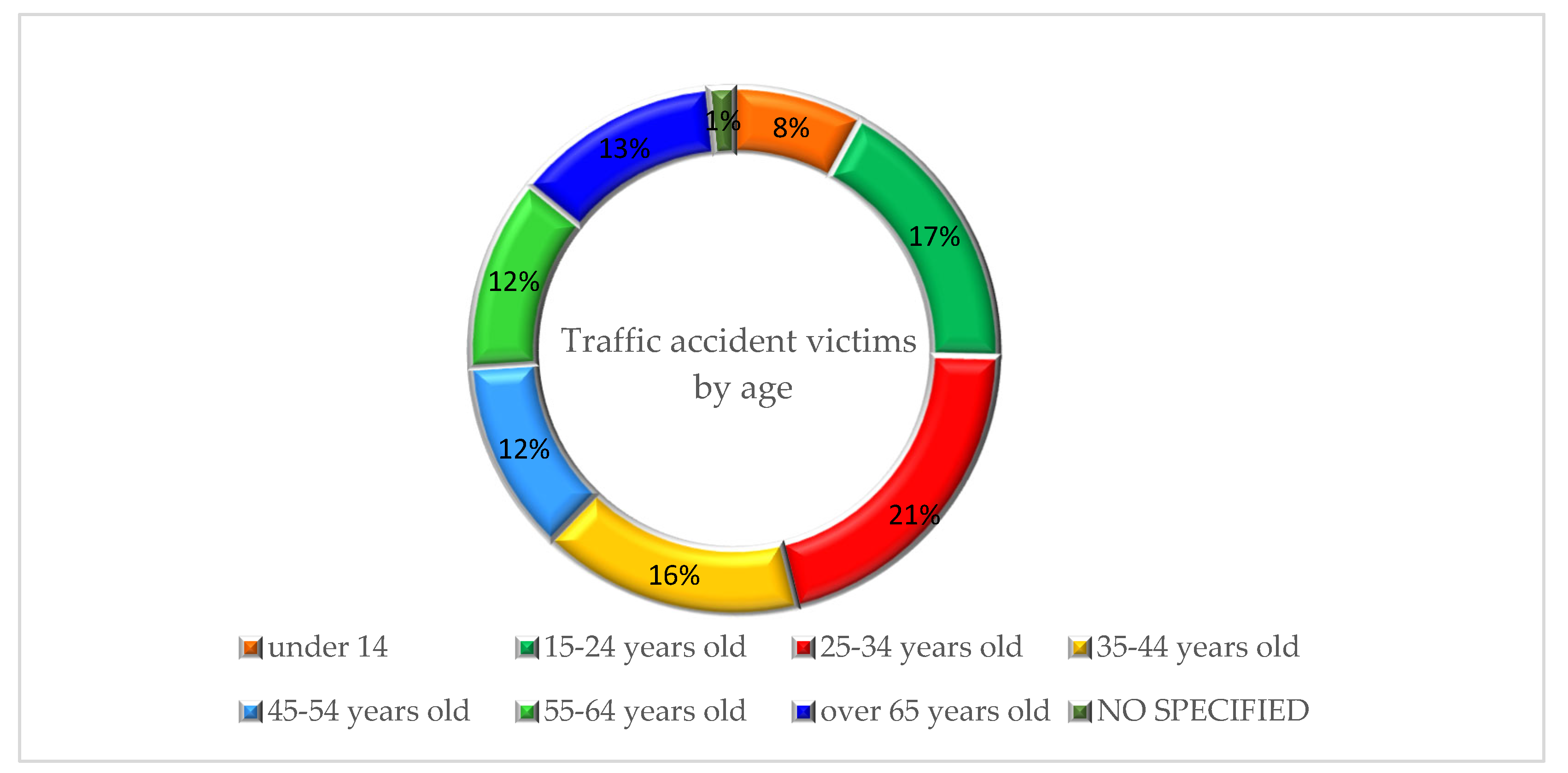
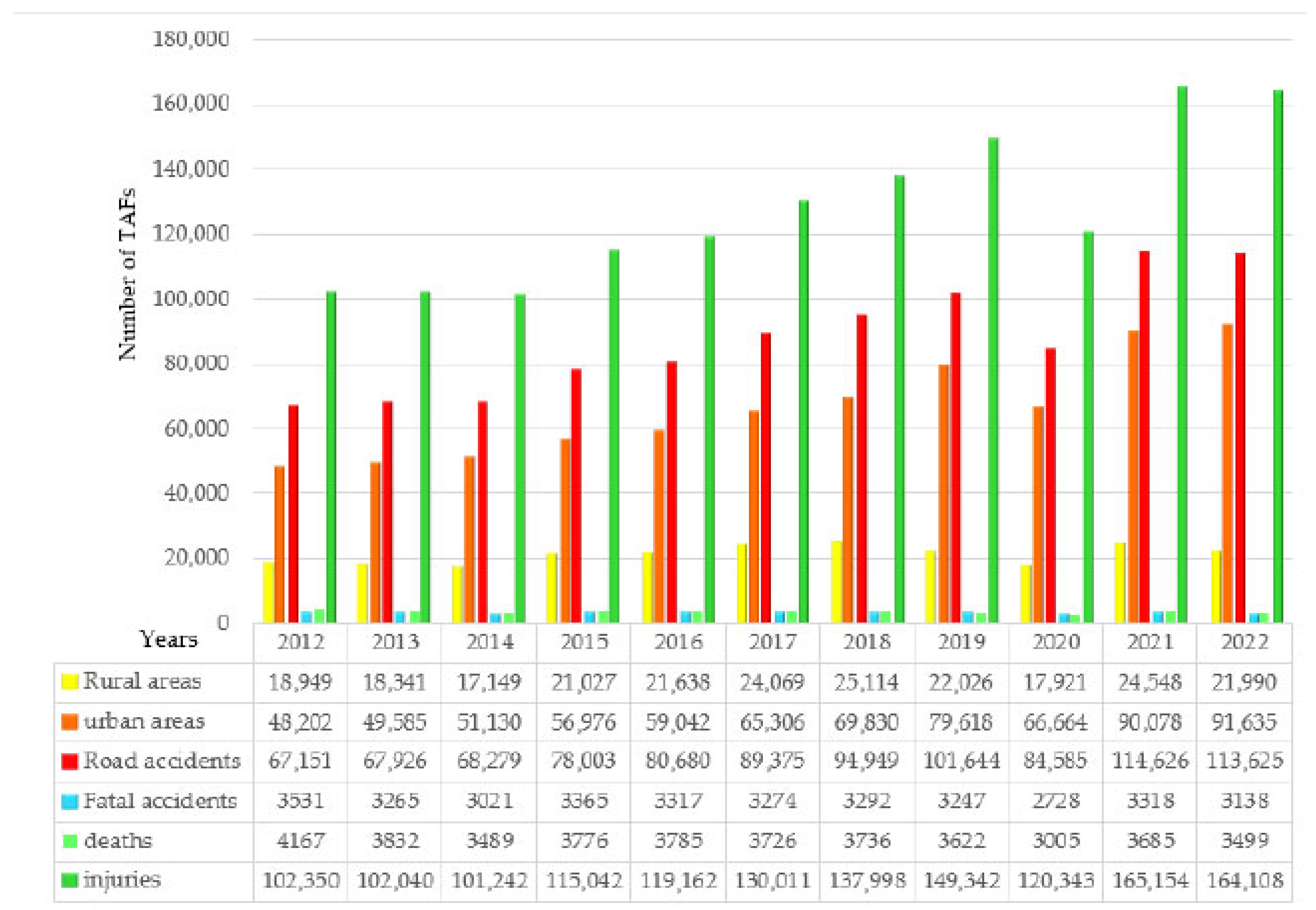
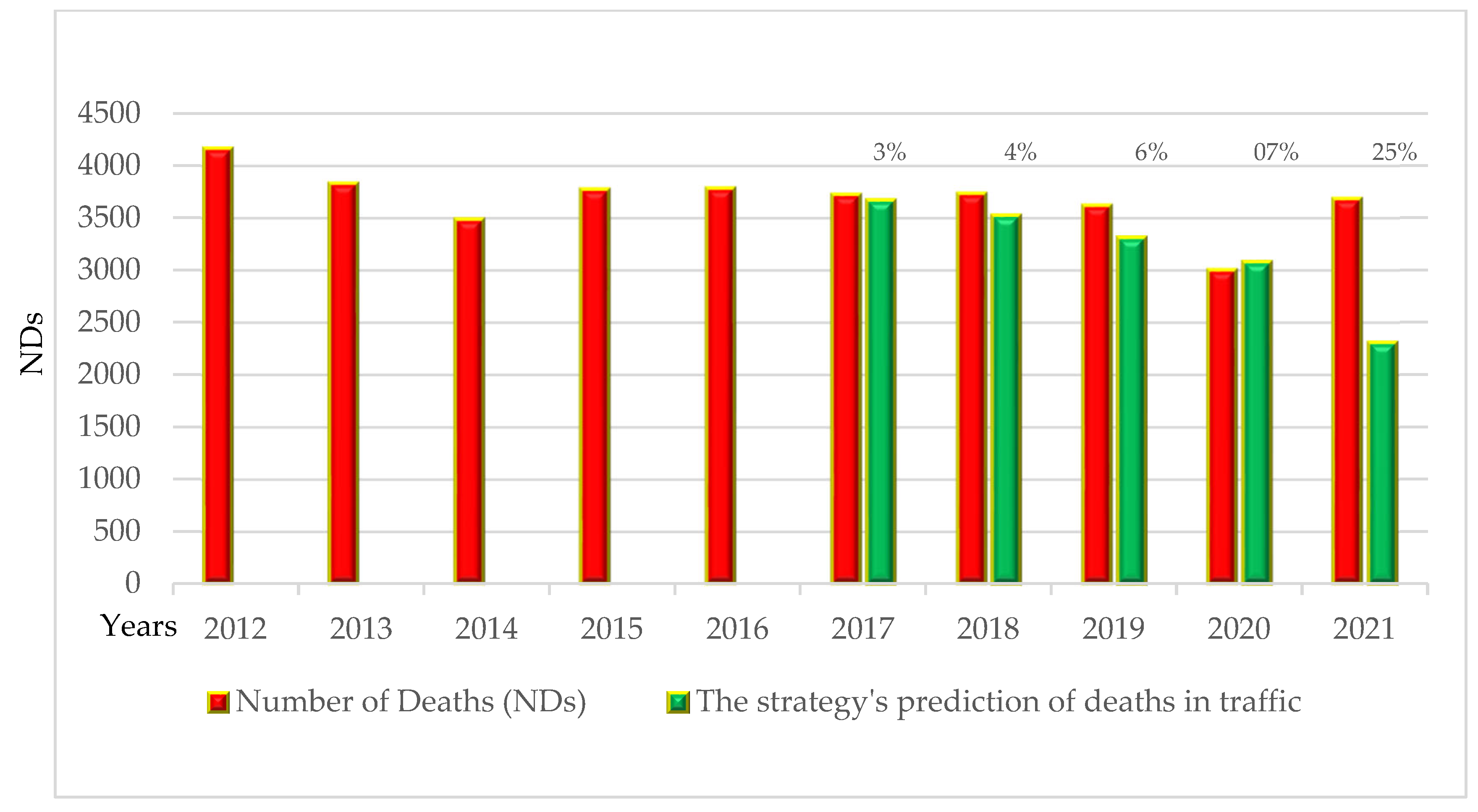
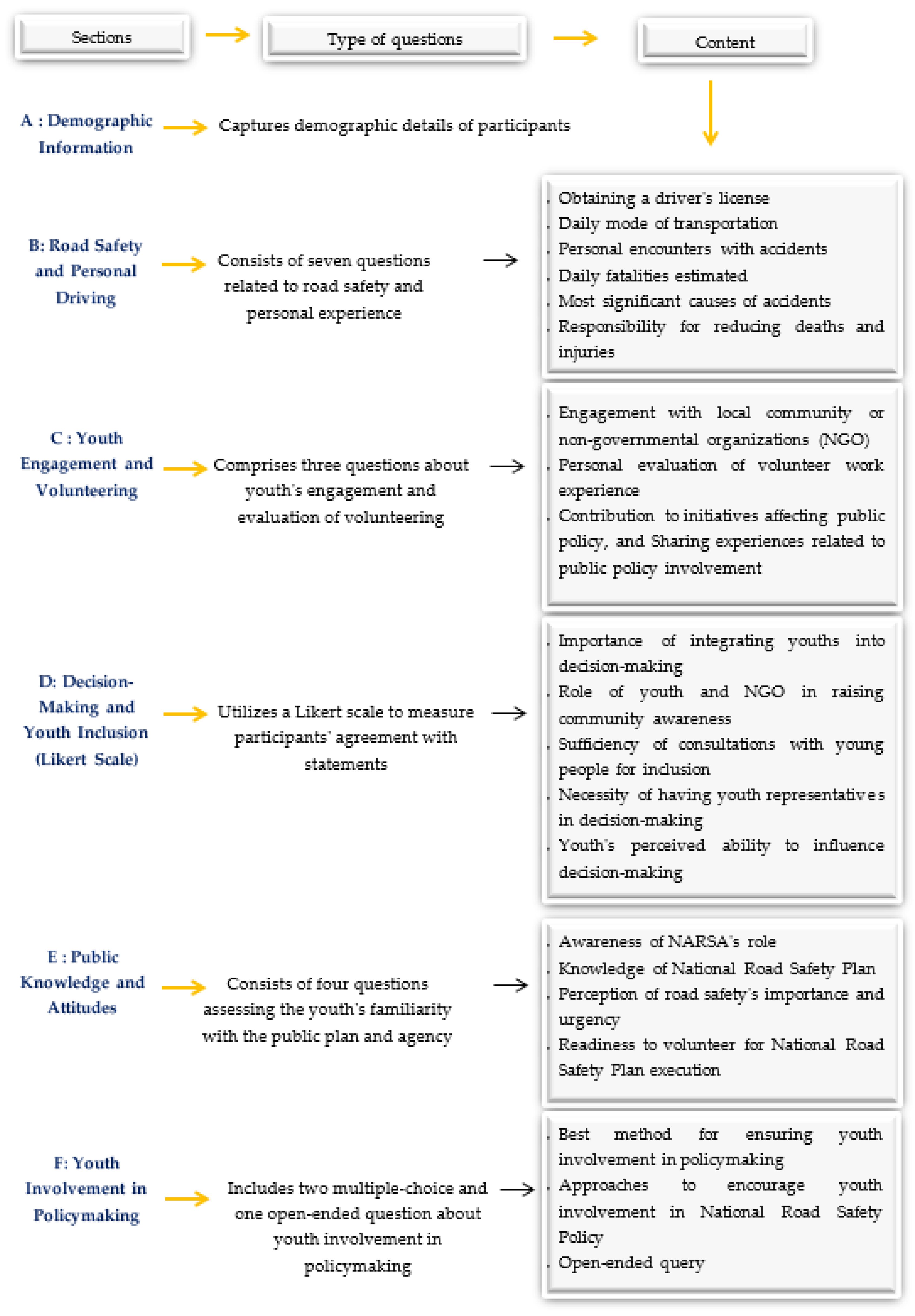

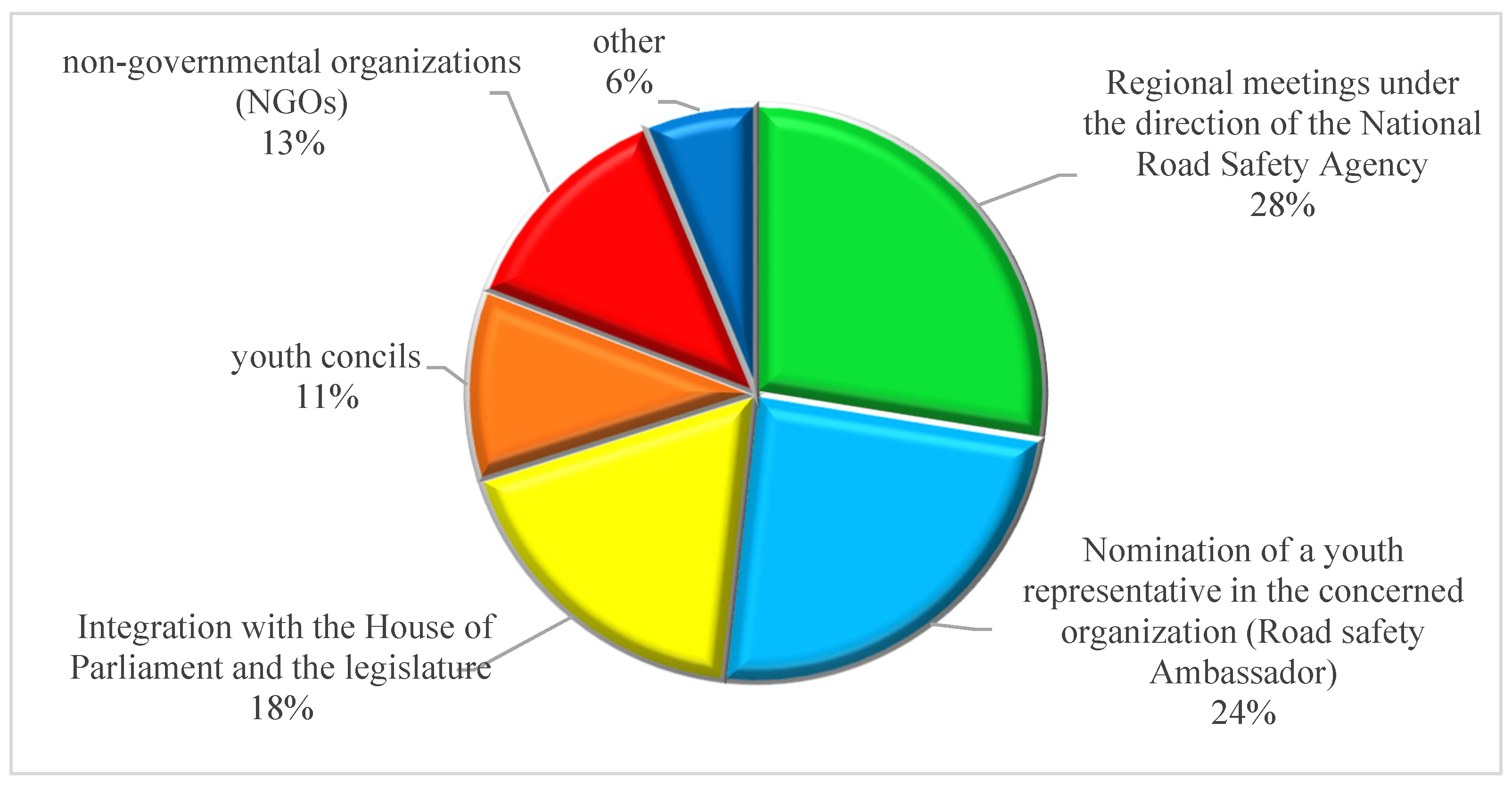
| Variables | Respondents | Percentage | |
|---|---|---|---|
| Age | 15–18 | 23 | 8.5% |
| 19–23 | 98 | 36% | |
| 24–29 | 95 | 34.9% | |
| 30–35 | 56 | 20.6% |
| Frequency | Percent | Valid Percent | Cumulative Percent | |
|---|---|---|---|---|
| Weather | 1 | 0.4 | 0.4 | 0.4 |
| Speeding | 156 | 57.4 | 57.4 | 57.7 |
| Vehicles | 4 | 1.5 | 1.5 | 59.2 |
| Driver behavior | 97 | 35.7 | 35.7 | 94.9 |
| Road conditions | 14 | 5.1 | 5.1 | 100.0 |
| Total | 272 | 100.0 | 100.0 |
| Frequency | Percent | Valid Percent | Cumulative Percent | |
|---|---|---|---|---|
| NARSA | 43 | 15.8 | 15.8 | 15.8 |
| Personal responsibility | 158 | 58.1 | 58.1 | 73.9 |
| NGOs | 18 | 6.6 | 6.6 | 80.5 |
| Driving schools and Training for Transportation Professionals | 23 | 8.5 | 8.5 | 89.0 |
| Ministry of Transport and Equipment | 30 | 11.0 | 11.0 | 100.0 |
| Total | 272 | 100.0 | 100.0 |
| Sections | Youth’s Recommendations |
|---|---|
| Traffic law |
|
| Traffic signals and infrastructure |
|
| Driving licenses and professional driving |
|
| Educational system |
|
| Public awareness |
Methods to spread awareness:
|
| Drugs and corruption |
|
| Promoting sustainability: environmental conservation and car maintenance |
|
| Strategic Issues - The National Road Safety Strategy | Action Guidelines | Survey Finding - Recommendations for Action |
|---|---|---|
| 1 Pedestrians |
|
|
| 2 Motorized two- and three-wheelers |
| |
| 3 Single-vehicle accident |
| |
| 4 Children under 14 years old |
| |
| 5 Professional transportation |
|
Disclaimer/Publisher’s Note: The statements, opinions and data contained in all publications are solely those of the individual author(s) and contributor(s) and not of MDPI and/or the editor(s). MDPI and/or the editor(s) disclaim responsibility for any injury to people or property resulting from any ideas, methods, instructions or products referred to in the content. |
© 2024 by the authors. Licensee MDPI, Basel, Switzerland. This article is an open access article distributed under the terms and conditions of the Creative Commons Attribution (CC BY) license (https://creativecommons.org/licenses/by/4.0/).
Share and Cite
Bohdidi, Z.; Cherif, E.K.; El Azhari, H.; Bnoussaad, A.; Babounia, A. Enhancing Road Safety Decision-Making through Analysis of Youth Survey Data: A Descriptive Statistical Approach. Safety 2024, 10, 45. https://doi.org/10.3390/safety10020045
Bohdidi Z, Cherif EK, El Azhari H, Bnoussaad A, Babounia A. Enhancing Road Safety Decision-Making through Analysis of Youth Survey Data: A Descriptive Statistical Approach. Safety. 2024; 10(2):45. https://doi.org/10.3390/safety10020045
Chicago/Turabian StyleBohdidi, Zohra, El Khalil Cherif, Hamza El Azhari, Ayman Bnoussaad, and Aziz Babounia. 2024. "Enhancing Road Safety Decision-Making through Analysis of Youth Survey Data: A Descriptive Statistical Approach" Safety 10, no. 2: 45. https://doi.org/10.3390/safety10020045
APA StyleBohdidi, Z., Cherif, E. K., El Azhari, H., Bnoussaad, A., & Babounia, A. (2024). Enhancing Road Safety Decision-Making through Analysis of Youth Survey Data: A Descriptive Statistical Approach. Safety, 10(2), 45. https://doi.org/10.3390/safety10020045









